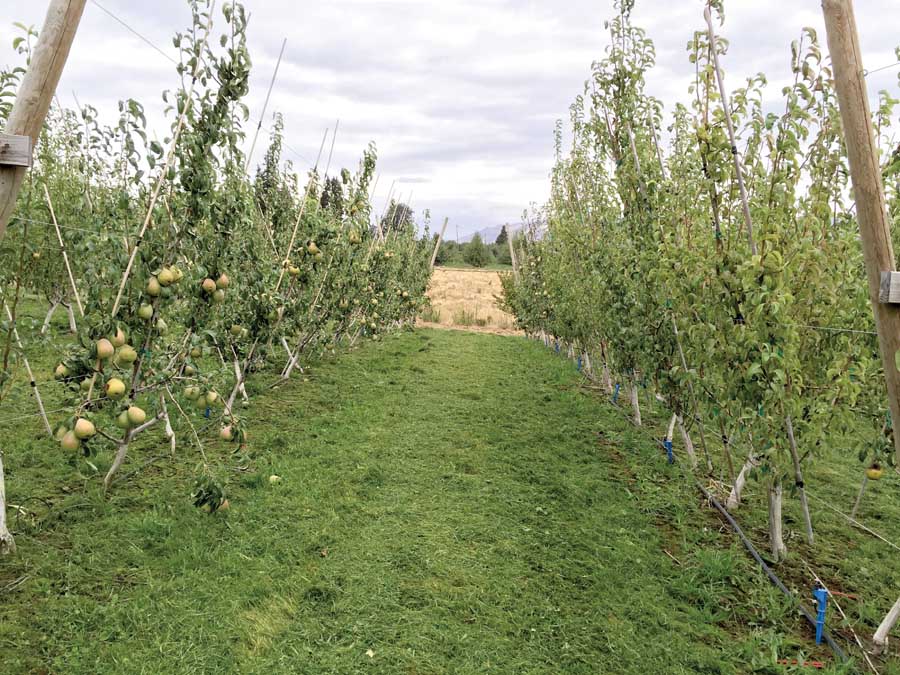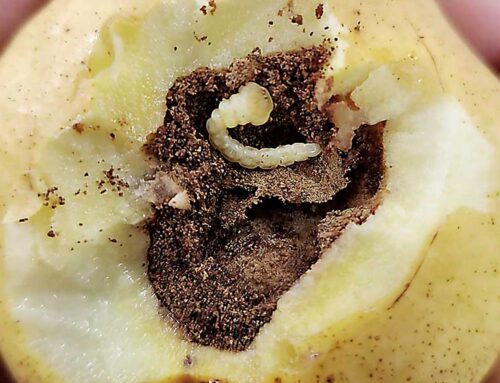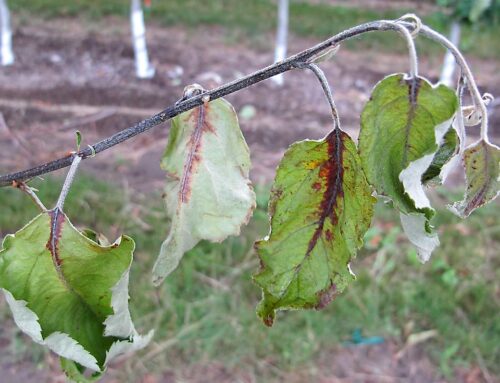Optimal performance of pears on trellises will continue to be elusive without a full dwarfing rootstock.
Existing varieties can cut tree size by 30 percent, but to deliver the kind of light penetration necessary for successful production on a trellis, tree size needs to be reduced by an additional 20 percent.

A telling comparison: A fourth-leaf d’Anjou on Amelanchier rootstock bearing fruit (left) easily outproduced the barren fourth-leaf d’Anjou on OHxF.87 on the right. (Courtesy Todd Einhorn)
European growers and southern U.S. growers get all the dwarfing they need from quince rootstock.
Unfortunately, quince lacks the cold-hardiness necessary to withstand Pacific Northwest winters, to say nothing of those of the Northeast.
There are two rootstock prospects undergoing late-stage testing that continue to outperform the rootstocks colder-climate growers are forced to use. Developed in Germany, Amelanchier continues to do well in field trials in Oregon, and a quince rootstock research project is poised to enter a North American testing phase.
Amelanchier
Amelanchier trials in Oregon continue to show the rootstock’s superiority to Old Home by Farmingdale 87, significantly outdistancing the industry standard’s near-barren limbs with good fruit and flower production.
A superior dwarfing rootstock, Amelanchier should shed more light on pears in trellises, especially in lower canopies, which is an ongoing problem with OHxF.87.
It tests hardy to minus 40 degrees Fahrenheit, and, though there is still a ways to go, its precocity promises heavier production for the life of the tree.
The plant is a genus of the Rosaceae family, consisting of about 25 species of deciduous shrubs and small trees, many of which are native to North America.
Its bark is smooth, gray or, less commonly, brown. It has a five-petaled white flower and produces red to purple edible fruit. There are 32 Amelanchier ornamental cultivars and 25 Amelanchier cultivars grown for fruit.
According to documents filed by the University of Saskatchewan Plant Science Department with the International Cultivar Registration Authority, the word “Amelanchier” is derived from a French word meaning “small apple.”
The plant has an uncommonly large list of common names with some interesting folklore attached to them. (Read “By any other name” below.)
Early returns
Michael Neumüller, a horticulture researcher at the Bavarian Fruit Center in Hallbergmoos, Germany, has developed inter-specific and intra-specific Amelanchier hybrids.
His goal was to produce a cold-hardy rootstock for pears, which he succeeded in doing.
“He produced an extraordinarily cold-hardy plant, hardy to minus 40 degrees Celsius in midwinter, which showed relatively little damage at that temperature,” said Todd Einhorn, a Michigan State University horticulture associate professor. (Minus 40 degrees Celsius happens to be equal to minus 40 degrees Fahrenheit.)
In trials Einhorn conducted at Oregon State University prior to his moving to MSU in August, the rootstock was precocious in the second leaf.
“It was incomparable to OHxF.87. Grafted with Anjou scions, it yielded 20 to 30 bins per acre in its third and fourth leaf, while OHxF.87 had few flowers and no fruit,” he said.
For plantings done with no interstems, Einhorn described its dwarfing as extraordinary. “On Anjou, it exhibited the degree of dwarfing within the range of what you’d expect to see on M.9 and M.27 apple rootstock,” he said.
Einhorn also saw 50 to 60 flower clusters per tree in the second and third leafs. “In the fourth and fifth leaf, we saw up to 200 flower clusters per tree,” he said.
Quince trials
For the past several years, Einhorn also has investigated the use of quince as a rootstock in northern climates, looking for many of the same rootstock qualities Neumüller discovered in Amelanchier.
Used extensively in Europe and in warmer climates in North America, quince isn’t hardy enough to survive locations where temperatures drop below zero and snow cover persists through the winter.
Good Fruit Grower has been tracking the progress of Einhorn’s quince rootstock trials. (Read “Quince evaluated for hardiness,” Good Fruit Grower, September 2011).
His work began in 2009 when he and Joseph Postman, the curator of the U.S. Department of Agriculture’s National Clonal Germplasm Repository Collection in Corvallis, Oregon, evaluated a subset of the quince collection for cold-hardiness, selecting 60 varieties for initial review.
From that group, 22 varieties were as hardy or hardier than OHxF varieties. Along the way, they sent a portion of them to Richard Bell at the Appalachian Fruit Research Station in Kearneysville, West Virginia, to determine fire blight sensitivity.
Over the next five years, they winnowed the candidate list down to 14 accessions, always comparing candidate performance to that of OHxF.87.
Einhorn will begin testing these trees with and without Comice interstems and putting Bartlett and Bosc buds on top.
This trial begins in 2017. In 2018 and 2019, he will expand the trial to four states and one Canadian province: Michigan, Pennsylvania, New York, Washington and Nova Scotia.
He also plans to continue as chair of the pear rootstock committee of USDA’s NC-140 project, a multistate project aimed at boosting peach, cherry, pear and apple production through improved rootstocks.
Cornell trials
Before Terence Robinson, a Cornell University tree fruit physiologist, left for a three-year sabbatical, he set up a combined pear rootstock and training system trial at the New York Agricultural Experiment Station.
He also hired two postdoctoral research associates to oversee them in his absence.
Now into their fourth leaf, the trees are starting to fill out with few differences in growth due to spacing, one of the research associates, Jaume Lordan, reported during the International Fruit Tree Association study tour in New York state. He cautioned that the study was still in its early stage.
Robinson planted the fruit in three tree spacings: 3 feet between trees and 12 feet between rows at 1,210 trees per acre, 4.5-by-12 feet at 807 trees per acre and 6-by-12 feet at 605 trees per acre.
The three training systems they are evaluating are the tall spindle, V-trellis and biaxis. They are also evaluating three rootstocks within these systems — OHxF.69, 87 and Pyro 2-33 — and chose Bosc scions because of their cold hardiness and propensity for being sold as fresh fruit.
At this point, trees on a biaxis are smaller than the others because they spread their tree vigor over two axes. The smallest rootstock is the Pyro 2-33.
The greatest yields occurred on OHxF.69, followed by OHxF.87 and Pyro 2-33 “As expected, yield per acre was highest on the 3-foot spacing and lowest on the 6-foot spacing,” Lordan said.
Highest yields were observed on tall spindle, followed by V-trellis and biaxis. •
– by Dave Weinstock
By any other name…
Amelanchier is one of those plants blessed with a lot of common names. Plant registry databases and academic literature are peppered with references to them and the attached folklore.
The common name boasting the best traditions is the serviceberry. There are at least three fanciful stories about the root of that moniker.
One says early American settlers often didn’t bury the dead until the weather warmed and the ground thawed.
Travel was easier, too, so memorial services were delayed until the serviceberry bloomed.
Another version is also related to winter travel. It says serviceberry blooms at the same time Appalachian roads became passable enough for circuit preachers in the region to travel to remote communities to lead church services.
A third bit of folklore claims its name is a corrupted form of sarvisberry, the name Romans gave to the European mountain ash. Apparently, early American settlers thought the plant’s berries resembled sarvisberries.
Also named juneberry, it earned that label because its fruit ripens in June. Saskatoon, the largest city in Saskatchewan, is named for the Cree word for the Canadian variety of the plant.
It is also known as shadbush, so named because it blooms about the same time a fish species called shad runs in northeastern U.S. rivers.
Whatever it is called, an Amelanchier, by any other name, is still an Amelanchier.






Leave A Comment